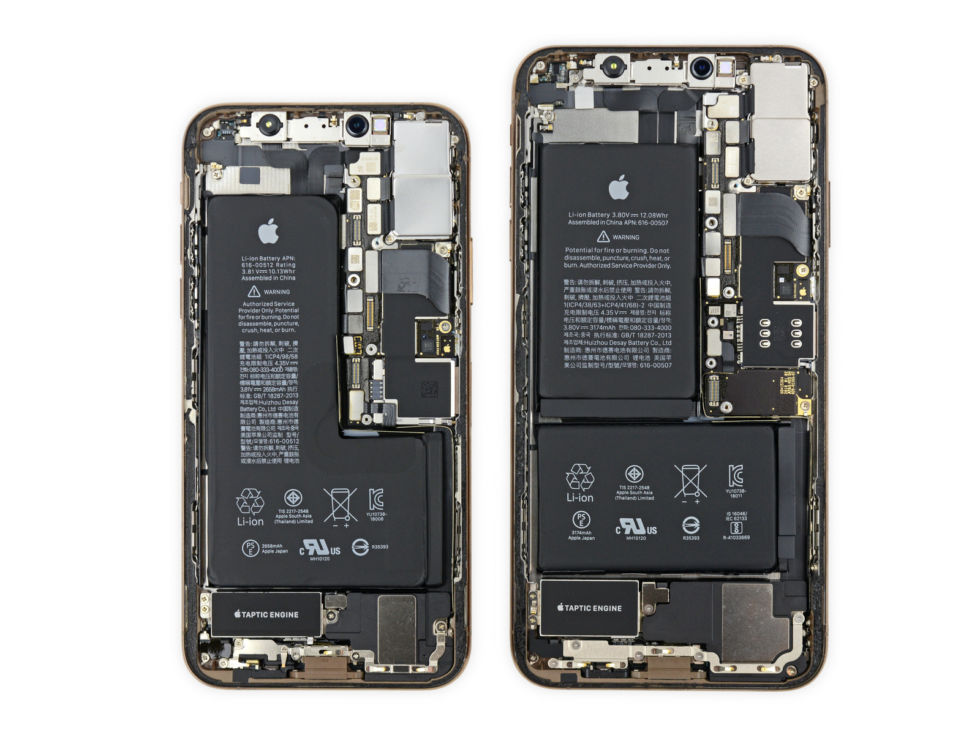iFixit: iPhone XS and XS Max - almost exact copies of the iPhone X with maintainability 6 out of 10

Apple almost every year launches new devices, and 2018 is no exception. About what was presented at the company's annual event, they already wrote on Habré. Among other interesting and not very new products were presented new smartphones iPhone XS and XS Max.
While in Russia and other countries queues are lining up, places where they are sold for substantial sums, iFixit hardware experts received their own copies of the phones and immediately dismantled them.
According to experts, as the gadgets were being disassembled, their similarity with the previous flagship of the company, called the iPhone X, made everyone more surprised. Actually, this is not particularly surprising, because each new iPhone model is a rethought and refined old one. But in the case of new models, the similarity is very obvious.
')
One of the main differences is the updated battery design. If the iPhone X had two of them, which is completely uncharacteristic of the company's phones and tablets, then at XS they “merged” and already represent a single whole. All this looks still strange, but it still became a bit more convenient to deal with the combined battery than with the separate ones. By the way, the XS Max decided to leave two batteries instead of one.

Virtually all other components are very similar to those in the iPhoneX. In addition to the battery, the differences are in the strip of the antenna, launched in the lower part of the case of each of the mentioned device models (see fig. Above). According to experts, this is done in order to prepare gadgets to work in gigabit LTE networks. The cameras are modified, the taptic engine is slightly increased, the same goes for the motherboard of the iPhone XS Max.
The battery capacity of the XS is slightly lower than the iPhone X battery and is 2659 mAh instead of 2716 mAh. The XS Max situation is different - the phone has a larger display than the XS, so the battery is installed more capacious, 3179 mAh. According to the company, the energy efficiency of smartphones is once again improved, which, in principle, the corporation says every year.
The iFixit specialists gave each of the new smartphones a 6 out of 10 maintainability assessment, which is not bad in principle. Replacing the display and the battery, the most frequent repair operations, are not particularly difficult, so there are practically no problems with bringing devices that failed for one reason or another.
By the way, due to the fact that the phones are protected from dust and moisture according to the IP68 standard, returning the device to water resistance after repair can be a difficult task. Another problem is that the phone cover (of both models) is covered with glass. There are craftsmen who, thanks to a long practice, have learned how to remove damaged glass and stick on a new one, but there are few of them.
 IPhone XS and XS Max Cameras
IPhone XS and XS Max CamerasAs for the device configuration, the iPhone XS is equipped with a 5.8-inch Super Retina HD OLED display, plus the new Apple A12 Bionic processor. The rear camera has a resolution of 12 MP, front - 7 megapixels, plus technology TrueDepth.
In addition to these two models, Apple introduced the third, called the iPhone XR. It is an alternative to last year’s G8, both conventional and Plus. The XR has the same processor as the iPhone XS, plus the same camera. The difference is that instead of the OLED-matrix, an LCD with a resolution of 1792 by 828 pixels and 326 pixels per inch is used here. The protection of the phone is somewhat worse than that of the “colleagues”, the device is standardized as IP67. The description of the gadget says that it can be immersed in water to a depth of one meter for up to half an hour.
By the way, the founder of iFixit has been promoting the idea of the “right to repair” for several years, which, in particular, concerns Apple’s desire to service its phones independently, without the help of third-party services. The latter can not get in the usual way neither the hardware (details) for the iPhone, which is not repaired by Apple, nor the software.
If the iFixit head does achieve its goal, then unauthorized service centers will have access to the entire Apple ecosystem, including some of the parts that are required to replace the failed ones.
Source: https://habr.com/ru/post/424069/
All Articles